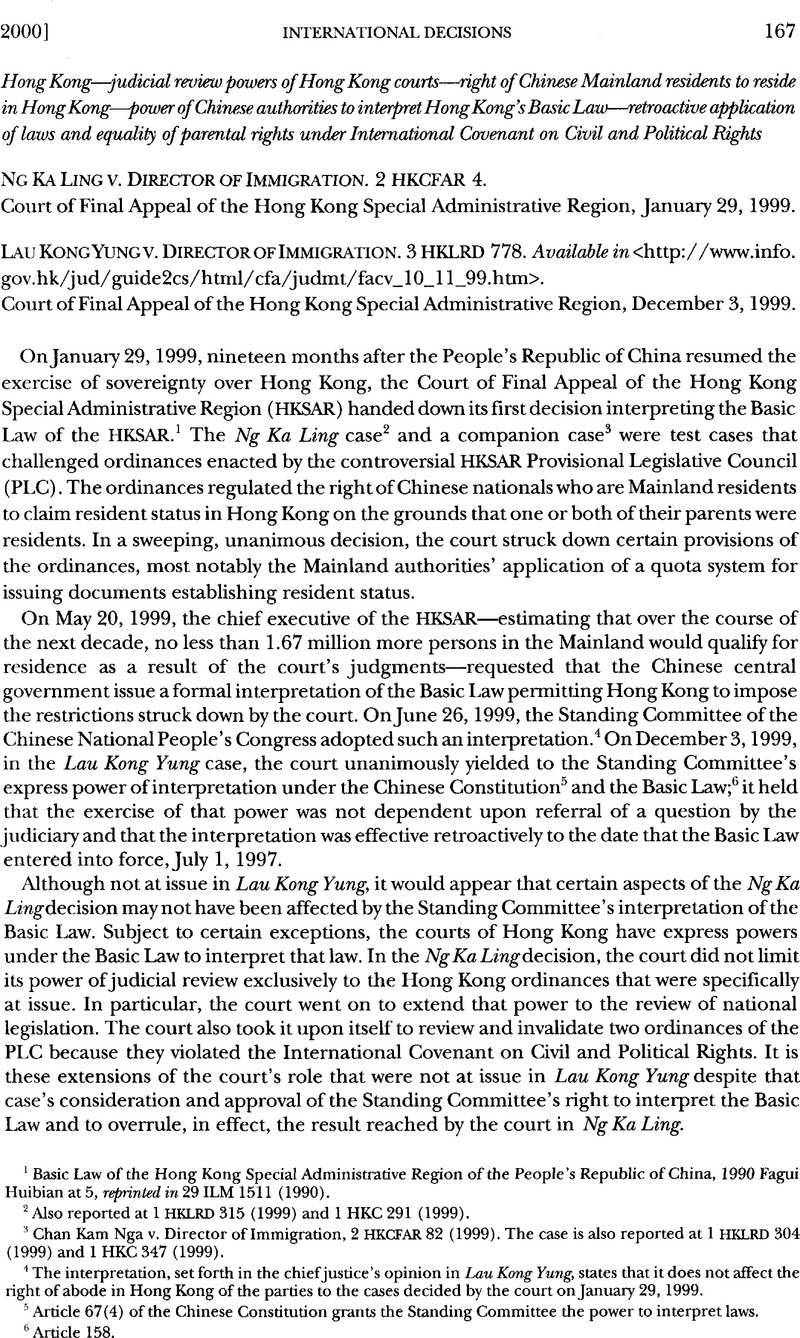Article contents
Ng Ka Ling v. Director of Immigration
Published online by Cambridge University Press: 27 February 2017
Abstract

- Type
- International Decisions
- Information
- Copyright
- Copyright © American Society of International Law 2000
References
1 Basic Law of the Hong Kong Special Administrative Region of the People's Republic of China, 1990 Fagui Huibian at 5, reprinted in 29 ILM 1511 (1990).
2 Also reported at 1 HKLRD 315 (1999) and 1 HKC 291 (1999).
3 Chan Kam Nga v. Director of Immigration, 2 HKCFAR 82 (1999). The case is also reported at 1 HKLRD 304 (1999) and 1 HKC 347 (1999).
4 The interpretation, set forth in the chief justice's opinion in Lau Kong Yung, states that it does not affect the right of abode in Hong Kong of the parties to the cases decided by the court on January 29, 1999.
5 Article 67(4) of the Chinese Constitution grants the Standing Committee the power to interpret laws.
6 Article 158.
7 1 HKLRD at 338G–H, 1 HKC at 324D–E.
8 1 HKLRD at 337F–G, 1 HKC at 323C–D.
9 1 HKLRD at 3371, 1 HKC at 323F. Article 31 of China's Constitution provides, “The state may establish special administrative regions when necessary. The systems to be instituted in special administrative regions shall be prescribed by law enacted by the National People's Congress in the light of the specific conditions.”
10 The definition of permanent residents in Article 24 had its origin in Part XTV of Annex I of the Sino-British Joint Declaration regarding the return of Hong Kong to Chinese control. The first three categories of Hong Kong permanent residents were identified in Part XIV as follows: “All Chinese nationals who were born or who have ordinarily resided in Hong Kong before or after the establishment of the HKSAR for a continuous period of 7 years or more, and persons of Chinese nationality born outside Hong Kong of such Chinese nationals.” Part XIV also states, “Entry into the HKSAR of persons from other parts of China shall continue to be regulated in accordance with the present practice.”
11 The preamble of the interpretation subsequently adopted by the Standing Committee indicates that such a reference should have been made.
12 1 HKLRD at 347H, 1 HKC at 333I–334A.
13 1 HKLRD at 321A, 1 HKC at 302B.
14 1 HKLRD at 3521, 1 HKC at 339F.
15 The Provisional Legislative Council was formed by the Preparatory Committee for the HKSAR, which was, in turn, formed by the National People's Congress. The PLC lasted until the First Legislative Council took office in July 1998.
16 Frank Chin, Judgment Call, Far East. Econ. Rev., March 4, 1999, at 20.
17 The clarification, NgKaLingv. Director of Immigration (No. 2), can be found at 1 HKLRD 577 (1999) and 1 HKC 425 (1999), available in http://www.info.gov.hk/jud/guide2cs/html/cfa/judmt/facv_14_16_98a.htm>.
18 Article 43 provides, “The Chief Executive of the HKSAR shall be accountable to the Central People's Government and the HKSAR in accordance with the provisions of this Law.” Article 48(2) provides, “The Chief Executive shall be responsible for the implementation of this Law and other laws which, in accordance with this Law, apply in the HKSAR.”
19 The interpretations were published in the People's Daily (overseas edition) June 28, 1999.
20 This interpretation effectively overruled Chan Kam Nga, supra note 3. Without the requirement of having a Hong Kong parent at the time of birth, many more people would be eligible for Hong Kong resident status in virtue of their parents’ having become Hong Kong residents after seven years in continuous residence there.
- 3
- Cited by




